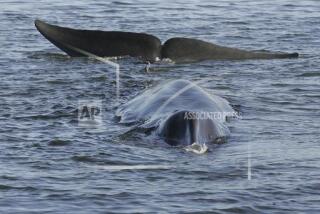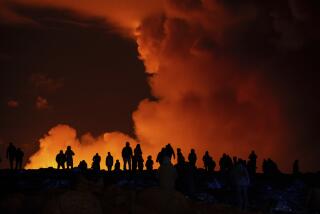Bringing in the sheep in Iceland is a fall celebration full of laughter, drinking and music
- Share via
Reporting from Skagafjordur, Iceland — “You must come for the rettir,” my friend Kristin said.
It’s her favorite time of year in Iceland — the annual fall roundup where Icelandic farmers on horseback retrieve their grazing flocks from the mountains and drive them into specially designed sorting rings called retts.
This boisterous celebration is filled with laughter, drinking and music, punctuated by Icelandic ballads and spontaneous games of tug of war while friends and neighbors help one another wrangle their sheep.
“This is the fall party for countrymen,” Kristin said, and extra participants are welcome.
I couldn’t pass up this chance to get a glimpse of rural Icelandic culture. On a chilly day in mid-September, I drove three hours north from Reykjavik to Kristin’s home in Skagafjordur, a farming region along Iceland’s northern coast.
You don’t have to know someone to join in, either; there are opportunities to join the “fall party.”
Rounding up
Early the next morning we drove deep into the valley of Maelifellsdalur, where Kristin’s husband, Leo, would ride with their friend Sara Reykdal. We bumped along a rough dirt track that crossed rocky streams and eventually arrived at the windswept top of a plateau.
It was bitterly cold even though the sun was shining; I quickly piled on every layer I had brought. A fence with a single gate opened onto the highlands, Iceland’s vast, virtually uninhabited interior of tundra cut by glacial rivers.
The hardiest riders had set out days ago to reach the most distant sheep near Hofsjokull glacier. Now, our group would help corral the ever-growing herd and direct them along the final leg through the valley.
Near the gate, 15 riders clustered with their mounts, braced against the wind. Several Icelandic sheepdogs whirled excitedly underfoot.
Sara stood coolly beside her horses. Her sister, Tota, manages their family farm, Starrastadir, meaning “place of the blackbird.” Sara’s 17-year-old son, Ulfar, waited nearby, bright red hair peeking out from beneath his riding helmet.
Everyone sported yellow safety vests for visibility and walkie-talkies for communication — no cell service here.
“This is just the way we breed sheep in Iceland,” Sara told me. Shortly after lambing time in May, farmers release their flocks to live all summer off the rich highland vegetation.
“If you would keep them home, they would be depressed,” Sara said. “They want to be free.”
The group rode to direct the oncoming herd as a wave of shaggy wool squeezed through the gate.
Most of the animals obediently followed the valley road, but a few had other ideas. One recalcitrant ram balefully stared down a rider . . . then bolted up the hill into the highlands, leaping past hollering children.
“Of course, it’s a black sheep,” Kristin said, laughing.
We wended our way along the road, staying well behind the bleating crowd. The riders formed lines up and down the valley walls, moving forward only when every sheep was heading in the right direction.
“If you have some naughty sheep, they can cause a lot of trouble,” Kristin said. “The riders hate it, but this is what I love — because it’s the action.”
Sara and Ulfar worked in tandem, aided by their faithful sheepdog Ronja, clearing each ridge one by one. They reached dizzying heights, sometimes scaling steep cliffs to nudge crafty creatures into the valley.
This is the best time of the year for the dogs, Sara told me, because they get to do what they were born to do.
Sunbeams rolled across the landscape, lighting slender waterfalls that trickled down the slopes. Small white flowers grew next to a rushing glacial stream. High on the hillside, I spotted a patch of snow, hidden in shadow beneath a rocky crag. It hadn’t melted all summer.
We relaxed near the mouth of the valley, waiting for dawdling sheep to catch up. Sandwiches were unwrapped, Viking brand beer cracked open and jokes started flying.
“Now is time for the small talk and gossiping,” Kristin said. We sat on the grass, savoring the sweet wild blueberries that covered the slope. A would-be troubadour began to sing, his voice rising in a lilting Icelandic melody as friends joined in.
As evening fell, we waved the flock into a holding pen, ready for sorting.
Inside the sorting ring
The next day, Kristin jounced us along a steep mountain road with perilous switchbacks to show me Stafnsrett, a traditional livestock sorting ring. Radiating from an open circle in the middle of the large rett were nearly 50 sections, each labeled with the name of a local farm: Austurhlid, Hafgrimsstadir, Vidiholt.
The rett was abuzz with people and animals: sheep bleating, dogs barking, friends hollering across the ring and chatting over the walls. Families picnicked beside an icy stream. The sun highlighted vivid geometric patterns on their handmade Icelandic sweaters. Here the sweaters weren’t souvenirs; they were work clothes.
I joined a lineup of locals in the holding pen, urging the flock to flee before us into the ring. We waved arms wildly, clapped hands and yelled — “Hah! Hah!” — sparking a stampede of thundering hoofs that flowed around us.
Some farmers claimed to recognize their sheep by each one’s “special facial expression,” Kristin told me, but they’re also identified by plastic tags in their ears. Locals charged into the melee, checking tags and dragging protesting animals to their proper sections.
Several tourists snapped photos and cheerfully waded into the scrum, trying their hand at sheep wrangling.
I was swept along by the tide, buffeted by creamy, pungent wool. When a ram tried to take a bite of my pants, I retreated to a perch on top of the wall.
Retts such as Stafnsrett can be found throughout Iceland. Some are hundreds of years old, constructed of weathered stones and still in use; others are sleekly modern.
Back at the rett near Maelifellsdalur, the team from Starrastadir was sorting the sheep we had helped round up. Sara manned the gate to their section, while Tota, Ulfar and Heidar Oskarsson, Sara’s partner, gathered the animals.
Kristin’s 15-year-old daughter, Alma, accompanied us. She was the picture of modern Iceland in her traditional sweater, knitted by Kristin, and a 66º North cap — the trendy Icelandic outerwear brand.
Alma was 4 years old when her parents brought her into the sheep sorting ring for the first time. “They wanted me to experience it because it’s an Icelandic tradition,” she said. “My dad held my hands and was walking with me. They were so big to me then.”
Now, the gentle bleating of the sheep reminds her of childhood.
On the farm
Stock sorted, team Starrastadir again took to horseback to lead their herd to their farm, where further selection would decide which sheep went to market and which would breed “new models,” Sara said.
I joined the family for dinner: lamb, of course, with rice, curry sauce and small yellow potatoes slathered with butter. The lamb was tender and sweet.
“You probably get the cleanest meat in the world in Iceland,” Heidar said.
The country’s regulations are strict: No growth hormones or preservatives are permitted. And because the sheep spend all summer eating grasses and berries, they’re almost completely free range, he said.
It’s a standard that Starrastadir and other Icelandic farms intend to maintain — and the rettir is an essential element.
“This has been going on for centuries,” Sara said. “I have been doing this for 30 years. My father did before, my grandfather [before him] and so on.”
It’s a beloved tradition, even though you’re tired for days afterward, Sara said. “The sheep roundup is something you do not want to miss,” she said. “It’s a part of your life — you do not want to lose it.”
If you go
THE BEST WAY TO REYKJAVIK, ICELAND
From LAX, WOW offers nonstop service to Reykjavik, and Delta, American, United, Iceland Air, Air Canada and British offer connecting service (change of planes). Restricted round-trip airfare from $430, including taxes and fees.
WHAT TO DO
Roundups for both sheep and Icelandic horses occur throughout the country on weekends from early September to early October. Dates for specific roundups are posted in late August on bbl.is, an Icelandic farmers’ news resource. (Website is in Icelandic but most browsers can translate into English.)
Experienced riders can participate in the roundups through multiday riding tours; rates range from $1,795 to $2,900 and usually include room and board and transfers from Reykjavík.
In Skagafjordur, family-run Horses and Tours offers trips to the Skrapatungurett horse roundup and Audkulurett sheep roundup, while Riding Iceland has a four-day trip to Laufskalarett, the largest horse roundup in Iceland. Ishestar offers three- to six-day trips for sheep and horse roundups around the country.
It’s free to join the final walk with a herd and visit retts. Most are in rural areas; four-wheel drive is required. You can stop at any of the N1 service stations along Iceland’s main roads to obtain maps and directions to retts in the area.
WHERE TO STAY
Hotel Tindastoll, 3 Lindargata, Saudarkrokur; 011-354-453-5002. Doubles from $330. Boutique hotel dating to 1884.
Siglo Hotel, 3 Snorrgatta, Siglufjordur; 011-354-461-7730. Doubles from $384. Scenic waterfront hotel on the Troll Peninsula.
Hotel Ranga, Sudurlandsvegur, Hella; (877) 234-7033. Doubles from $506. Eco-friendly hotel near the Rangarvallaafrettur sheep rett and the Seljalandsfoss waterfall.
Well-maintained campgrounds with electric hookups and clean bathrooms can be found in almost every town and recreational area. Pack a warm sleeping bag and flashlight.
September temperatures average between 38 to 50 degrees, though it can hit higher or lower. Sudden rain showers are common. Come prepared with rain gear, comfortable waterproof hiking boots, and lots of warm layers.
TO LEARN MORE
More to Read
Sign up for The Wild
We’ll help you find the best places to hike, bike and run, as well as the perfect silent spots for meditation and yoga.
You may occasionally receive promotional content from the Los Angeles Times.






